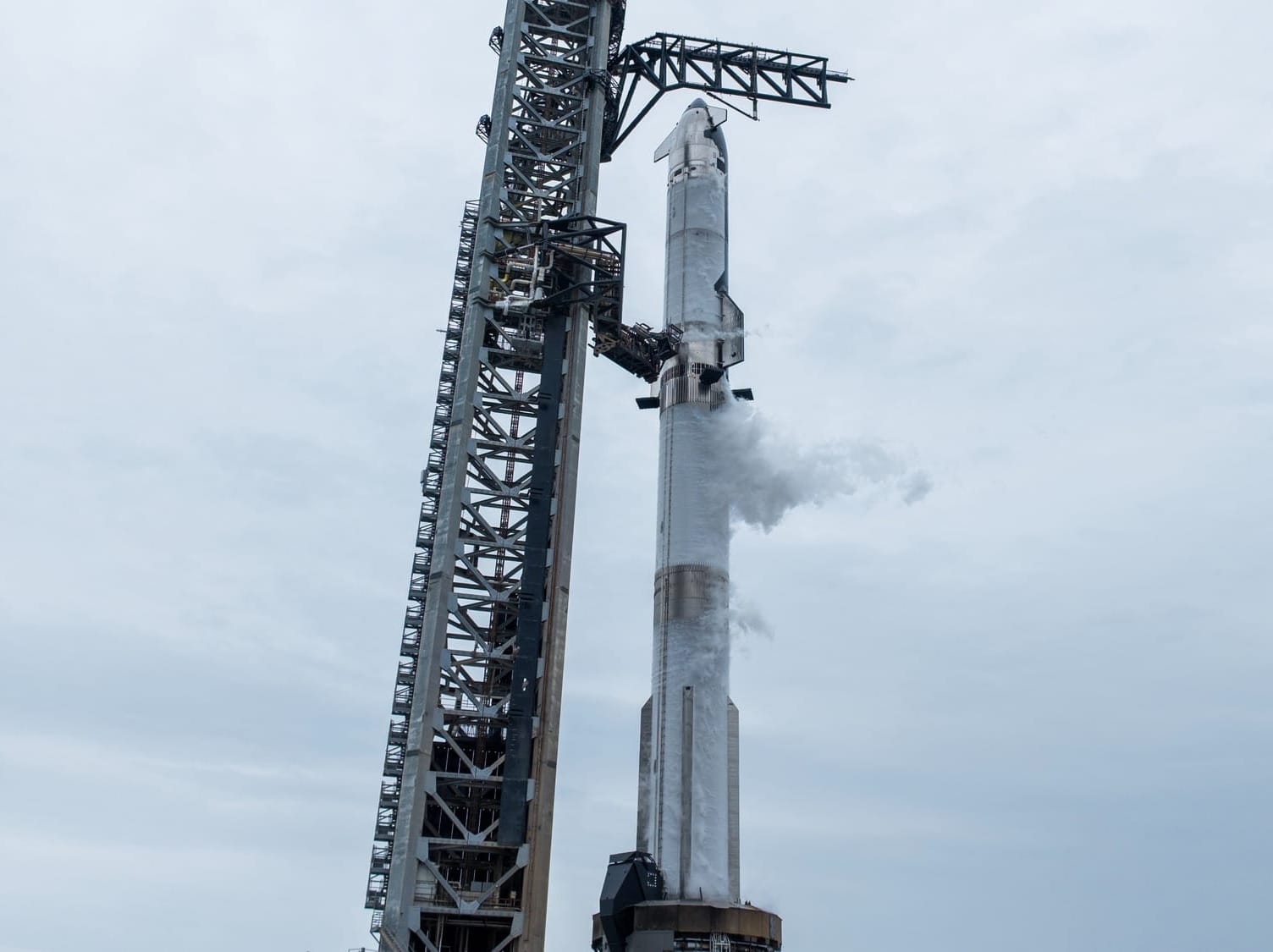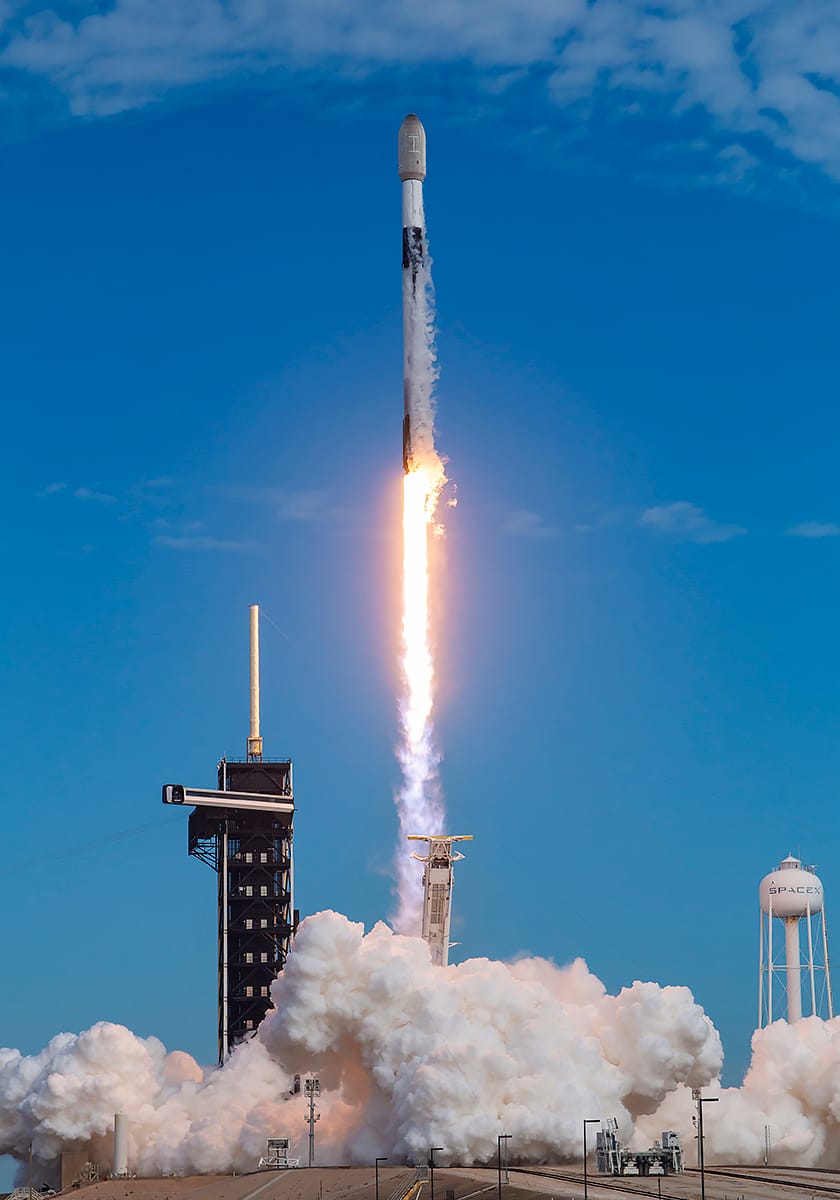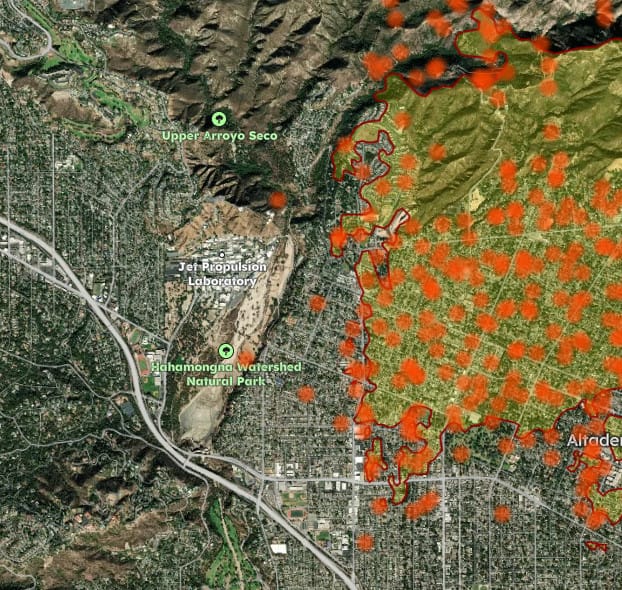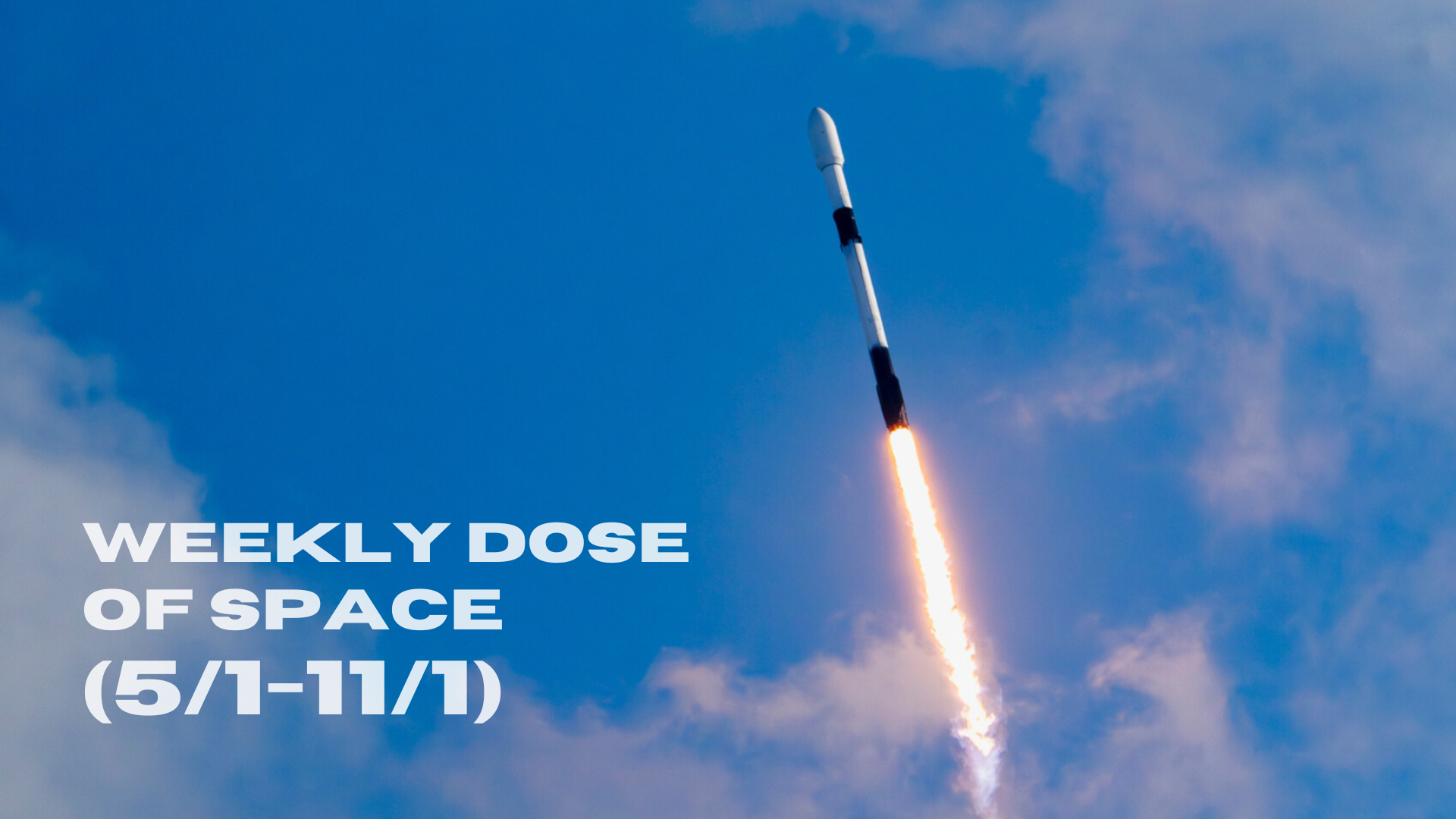Table of Contents
Welcome back to Weekly Dose of Space! This week had five launches occur again, with most delivering Starlink satellites. News this week had JPL temporarily close, Toyota investing in orbital rockets, and a water-fueled thruster planned to be tested in space. As always, we'll also look ahead to what the worldwide launch schedule might look like next week.
SpaceX
This week at Starbase began late on January 6th when Ship 33 was spotted being prepared for Starlink simulators to be loaded inside the payload section ahead of its rollout for Starship-Super Heavy's seventh flight test. Over on the Orbital Launch Mount Booster 14 had its hot-staging ring temporarily removed, likely to allow for final pre-launch checks. January 7th had Ship 33 loaded with the Starlink simulators along with Booster 14's hot-staging ring being reinstalled.
A few days later on January 9th Ship 33 was rolled out from the production site to the launch site, later in the day Ship 33 was lifted atop of Booster 14. A couple of days later on January 11th Booster 14 and Ship 33 performed a wet dress rehearsal of the launch countdown, loading both vehicles with liquid methane and liquid oxygen. Following the test Ship 33 was destacked from Booster 14 for final pre-launch checkouts.

Launches This Week
January 6th - Long March 3B/E with Shijian-25
China’s first launch of 2025 blasted off from Launch Complex 3 at the Xichang Satellite Launch Center with a Long March 3B/E sending Shijian-25 toward geostationary transfer orbit. Shijian-25 is stated as being a technological demonstration mission for refueling other spacecraft along with extending their operational lives.

January 6th - Falcon 9 with Starlink Group 6-71
A Falcon 9 lifted off from Space Launch Complex 40, in Florida, carrying twenty-four Starlink satellites to low Earth orbit. Supporting this launch was booster B1077, making its seventeenth flight and landing downrange on the drone ship 'Just Read The Instructions'.

January 8th - Falcon 9 with Starlink Group 12-11
Another Falcon 9 carried twenty-one Starlink satellites into low Earth orbit from Launch Complex 39A, in Florida. Booster B1086 supported this mission for its third flight, with a landing on the drone ship 'A Shortfall Of Gravitas' downrange.

January 10th - Falcon 9 with NROL-153
SpaceX launched another Falcon 9 with a batch of Starshield satellites, the military version of Starlink, from Space Launch Complex 4E, in California. This mission was supported by booster B1071, making its twenty-second flight and landing downrange on the drone ship 'Of Course I Still Love You'.

January 10th - Falcon 9 with Starlink Group 12-12
Another batch of Starlink satellites were launched to low Earth orbit atop of a Falcon 9 flying from Space Launch Complex 40. Booster B1067 supported this launch for its twenty-fifth flight, with it landing on the drone ship 'Just Read The Instructions' downrange.
This one life-leading Falcon rocket alone launched four Dragon missions (including eight astronauts) to the @Space_Station and more than 430 spacecraft to orbit in the past four years pic.twitter.com/WhodgPye4B
— SpaceX (@SpaceX) January 10, 2025
Booster B1067 landing on 'Just Read The Instructions' for the Starlink Group 12-12 mission, via SpaceX on X.
In Other Space News
JPL closed due to fire risk

Since January 7th a series of major wildfires have been spreading across the Los Angeles area, these fires have burned an estimated 36,700 acres, roughly 148 square kilometers. Due to the fires, NASA's Jet Propulsion Laboratory (JPL) was closed by mandatory evacuations, with JPL stating:
"The Jet Propulsion Laboratory is within the mandatory evacuation zone for the Eaton Fire and is closed to employees and visitors on Wednesday, Jan. 8. The laboratory will remain closed until Monday, Jan 13. Additional updates on the Laboratory’s status will be posted on this site (emergency.jpl.nasa.gov)." – "Currently, JPL facilities, labs and hardware are secured and protected. Deep Space Network operations, normally conducted at JPL, have been moved offsite to a back-up operations center." – "As of Tuesday night, employees were directed to work from home, with only a small number of critical personnel on-site Wednesday morning. Our Protective Services Department is maintaining constant communication with the Eaton Fire emergency command center, and the Laboratory is currently receiving assistance from the LA County Fire Department." – "The safety of our employees is our top priority. We also keep our neighboring communities—many of which are home to our employees and their families—in our thoughts as they endure the challenges and devastation of this fire."
JPL's Director, Laurie Leshin, added on January 8th:
"JPL is closed except for emergency personnel. No fire damage so far (some wind damage) but it is very close to the lab. Hundreds of JPLers have been evacuated from their homes & many have lost homes. Special thanks to our emergency crews. Pleases keep us in your thoughts & stay safe."
On January 10th JPL announced that essential personnel would be allowed back on site, in order to run and assemble various deep space spacecraft and missions. A fire crew is reportedly on-site at the Laboratory to protect its facilities.
With the extensive damage caused across the Los Angeles area, JPL and Caltech have set up a disaster relief fund to support employees and their families who have been displaced. More details on this fund can be found here.
Pale Blue to test water-based propulsion in space
Pale Blue, a Japanese space startup, announced on January 8th that it had signed an agreement with D-Orbit, an Italian in-space transportation company, to conduct two demonstrations of a small water-fuelled thruster in orbit during 2025. The thruster for the test is expected to be Pale Blue's 1U+ Water Ion Thruster.
Pale Blue describes the thruster as follows: 1U+ Water Ion Thruster (PBI) is a fully integrated propulsion system with its outstanding total impulse achieving 7,000 Ns, which makes it one of the highest options on market under this form factor. By using water as a propellant, the propulsion system has a number of additional advantages such as safety, ease of handling as well as propellant availability. Furthermore, this compact system is clusterable to meet a wider range of satellite missions.
Speaking on the agreement, Jun Asakawa, Co-founder and Cheif Executive Officer of Pale Blue, said:
“We are incredibly excited to conduct in-orbit demonstration of the world-first water-based ion thruster that is innovative and sustainable propulsion solutions to the space industry,” – “By partnering with D-Orbit, we are taking a significant step forward in validating the performance and reliability of our propulsion technology. This collaboration will enable us to meet the growing demand, while contributing to space sustainability. We are confident that our water-based propulsion system will redefine the future of satellite missions and open up new possibilities for space exploration.”
The two tests of the thruster are expected to launch on two separate D-Orbit ION Satellite Carrier spacecraft in June and October of 2025.
Toyota invests in orbital rockets
On January 6th, Akio Toyoda, Chairman of Toyota Motor Corporation announced that the automaker is exploring the development and production of orbital rockets, via an investment in Interstellar Technologies Inc. Speaking on the investment, Toyoda said:
“We are exploring rockets too, because the future of mobility shouldn’t be limited to just earth or just one car company, for that matter”
Toyota's investment into Interstellar Technologies was 7 billion Japanese Yen, approximately 44.4 million United States Dollars, and was done through Toyota's Woven City initiative.
Interstellar Technologies is a Japanese space launch company established in 2013 that has so far flown suborbital rockets. The company is currently developing a small rocket, set to debut in 2025, capable of carrying 250 kilograms to a 500-kilometer sun-synchronous orbit. A partially reusable rocket is also being worked on with a similar recovery plan to SpaceX's Super Heavy booster or Cosmoleap's Leap.
What to Expect Next Week
Starbase
SpaceX is currently preparing to perform Starship-Super Heavy's seventh flight test utilizing Booster 14 and Ship 33, the first 'Block 2' Starship upper-stage. This launch may take place no earlier than January 15th. Both vehicles needed for flight have also completed pre-launch static fires and individual tests.
January 13th - Jielong-3 with a to-be-announced payload
A Jielong-3 rocket may liftoff from a sea-based launch platform in the Yellow Sea and head to low Earth orbit.
January 13th - New Glenn for its debut flight
Blue Origin may launch its first New Glenn rocket from Space Launch Complex 36, in Florida. New Glenn's first stage, called 'So You're Telling Me There's a Chance', will attempt to land downrange on the drone ship 'Jacklyn'.
January 13th - Falcon 9 with Starlink Group 12-4
A Falcon 9 is expected to launch a batch of Starlink satellites to low Earth orbit from Space Launch Complex 40.
January 14th - Falcon 9 with Transporter 12
Another Falcon 9 is expected to perform the Transporter 12 dedicated rideshare mission to sun-synchronous orbit from Space Launch Complex 4E carrying payloads for dozens of customers.
January 15th - Falcon 9 with two lunar landers
Yet another Falcon 9 is planning to launch Firefly's Blue Ghost lunar lander and ispace's Hakuto-R lunar lander to a lunar transfer orbit from Launch Complex 39A.
January 15th - Starship-Super Heavy for its seventh flight test
SpaceX may perform its seventh flight test for its Starship-Super Heavy launch vehicle with liftoff and possible booster catch from the company's launch site in south Texas. The vehicles for this flight will be Ship 33, the first 'Block 2' Starship upper-stage, and Super Heavy Booster 14.
January 18th - Falcon 9 with Starlink Group 11-8
Another batch of Starlink satellites is expected to be launched into low Earth orbit atop Falcon 9 from Space Launch Complex 4E.







